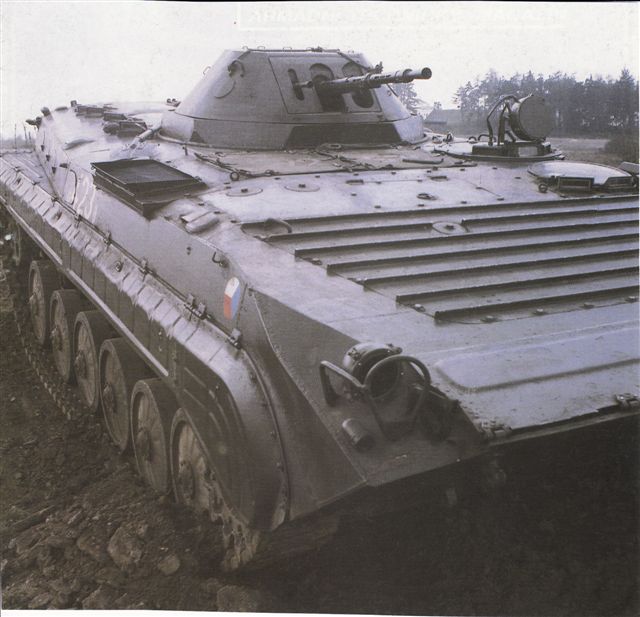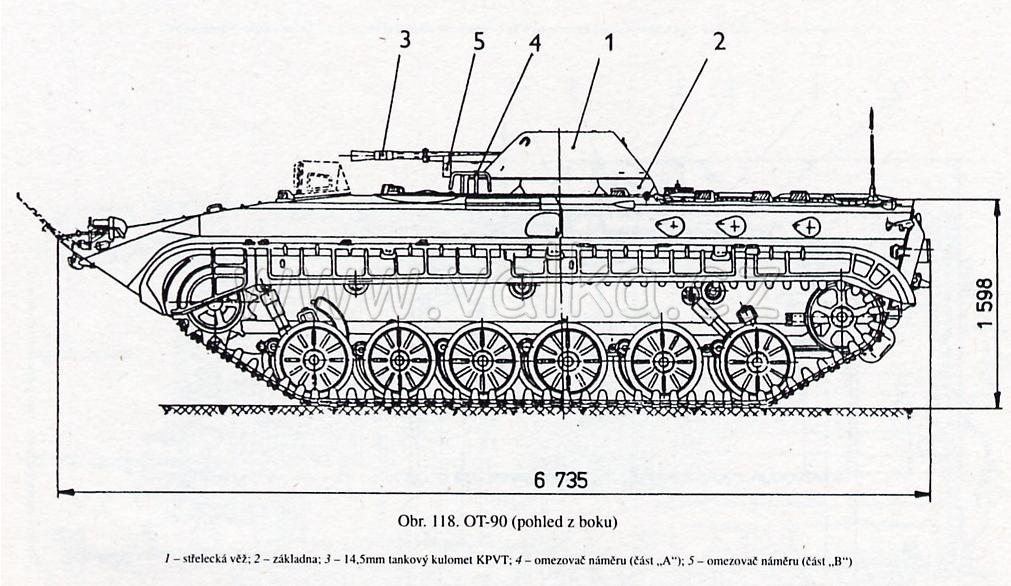Hello everyone,
first and foremost: I know some of you wrote me to make part 2 of the Finnish armor article. I won't. Here's the reason why: http://www.jaegerplatoon.net/MAIN.html - this website has all the info on Finnish armor you can possibly want and then some. If I knew this site existed (or rather, if I bothered to google before writing anything), I wouldn't have even started with it. So, go check it out if you are interested, I definitely will :) Anyway, since the site doesn't contain info on some "specialities" (like the famous BT-42), I'll be making an article about that later.
Today's topic however won't be tanks per se, but - in the spirit of the "tanks that failed" article I wrote some time ago - two Czechoslovak vehicles, that were... not very successful. To put it mildly.
OT-810 "HAKO", or "Hitler's revenge"
Ever since WW2, Czechoslovak army staff was impressed with the armored APC halftrack concept. From the early successes of the Blitzkrieg and the use of the halftracks by the Allies, it was decided straight after the war that the newly emerging Czechoslovak army needs these vehicles too.
There was also some background. For starters, the original SdKfz.251 vehicles were partially produced in former Czechoslovakia during the war (notably by Škoda Pilsen and Mürzzuschlag-Bohemia from Česká Lípa) - the production capacity was already there. Another German halftrack - the SdKfz.250 (Demag D-7) was also present in some significant numbers in renewed Czechoslovakia after the war ended and - finally - a number of International Harvester M5 halftracks (called "Internacionál" by Czechs) made their way to post-war Czechoslovakia via Soviet lend-lease.
After the war ended, Czechoslovakia was desperate to get their hands on as many armored vehicles in general as possible, since the new army needed new equipment and there was practically impossible to get large amounts of American or Soviet weapons (both the Americans and Soviets were reluctant to share, or the tanks simply weren't available) - the army decided to solve the issue by pressing trophy German vehicles (such as Panzer IV, Hummel and Nashorn) into service, until something better can be obtained (this was decided in 1945 already, it was still not sure we'd become a Soviet satellite by then). Based on this decision, it was decided to accept both the 251 and 250 into Czech army. The 251 factory designation was HKL-6 and the vehicle became known in the Czechoslovak army as "Hakl".
The vehicle was practically redesigned to OPp3N ("armored halftrack, 3ton, German") and available (captured) pieces were sent to the border guard units. A number of these vehicles were refitted with the Tatra T-928-3 engine (HKL-6p, D-7p) from 1952.
The vehicle was never really that much popular, but both were used in large numbers despite the fact that the world was slowly moving towards fully-tracked APC's (first attempts were made in WW2 already, with various US tank conversions or the German "Kätzchen" project of a fully tracked APC based on 38t suspension). By 1951, the Czechoslovak army was still operating 736 halftracks of various versions (most were the HKL-6p variants) and by 1957 it was 630 (captured, not newly-produced) halftracks, of which 476 were HKL-6p and 154 were D-7p (the D-7 was nicknamed "krátký hakl" - or "short hakl").
And this is where the development of the OT-810 begins. In 1948, Soviet Union allowed Czechoslovakia to develop its own halftrack (that's why Czechoslovakia never bought the Soviet BTR-152) and in the 50's, when the army was looking for something to replace the aging park of captured German halftracks, it was decided to develop a new one.
The OT-810 HAKO development was started in 1952 as a development of the original Hanomag HKL-6p (the HAKO designation means "Hanomag Kopřivnice"). In 1954 the development was stopped, but it started again in 1956. Compared to the original vehicle, the vehicle had a different engine, different superstructure shapes and the infantry compartment was covered with a roof (the original vehicle was open-topped). An initial batch of 10 vehicles was made between 1958 and 1959.
In the end, the vehicle was accepted into service under the OT-810 designation ("OT" means "Obrněný transportér" - "armored transport"). In the end, 1140 vehicles were made between 1960 and 1962 by PPS Detva (Slovakia).
The vehicle was NOT very popular, to put it mildly. It was hard to control and the infantry compartment was very cramped (even more than the original German halftrack) and the maintenance was not exactly easy either. While the original "Hakl" nickname stuck even for this Czechoslovak version, the vehicle gained a new nickname too: the soldiers called it "Hitlerova pomsta", ("Hitler's Revenge").
In active service, it was replaced rather fast with more modern vehicles, but it stayed in the army warehouses for very long time. Many actually survived past 1989 as "untouchable supplies" (in case Czechoslovakia was ever invaded), when the army got rid of all of them (last were sold in 1995). Many are owned by private owners and a lot of them have been converted to resemble German Sdkfz.251 (both by fans and moviemakers as props). In fact, there is only a dozen of functional original Sdkfz.251 halftracks in existence in the world, so if you see a "German" halftrack in some WW2 movie and it has the "correct" suspension type, it's most likely a converted OT-810.
As a sidenote, an interesting version existed: the OT-810D tank destroyer, armed with a 82mm recoilless gun.
OT-90 "Havel's Tiger"
OT-90 is a Czechoslovak BMP-1 conversion from the 90's - the original BMP-1 turret was replaced by the manual BTR-60PB turret from the OT-64A "SKOT" wheeled APC. This ridiculous refit had its roots right after the 1989. Basically, what happened was that in November 1990, two disarmament treaties were signed: one in Paris and one in Budapest - by president Václav Havel, costing Czechoslovak army and military industry dearly.
These treaties limited (amongst other things) the amount of tank destroyers, IFV's and APC's a signing nation can have at one time. Basically, Czechoslovakia at that time had too many BMP-1 and BMP-2 vehicles, which were classified not as APC's, but as IFV's (the criterium for that was a gun over 20mm caliber and ATGM launchers) and as such, they didn't fit the limits imposed by the treaties. That's why it was decided to convert some of them from IFV's to APC's by using old OT-64 turrets, armed with 14,5mm MG's. Furthermore, in order to keep the treaty terms, it had to be done REALLY quickly, much quicker than such an undertaking would normally take - in 1990 and 1991, 620 BMP's were converted this way. The result was a disaster.
The obvious problem was the firepower reduction. Furthermore, the "new" turrets were only manually operated, which was "fun" to do in high speeds. The quality of these conversions was (due to time constraints and the fact a lot were done "in the field") very low: for example the new turret rings were not made properly bended, making the whole turret stuck.
The vehicle (despite the new turret being lighter and less armed) performed worse than the original BMP when driving and wading, because the center of gravity was moved more to the front. Its armament was considered obsolete (regardless of the caliber, especially the 7,62mm coaxial SGMT MG). Furthermore, the vehicle commander had no way how to designate target azimuth direction to the gunner and the gunner's seat that was installed was so bad that the gunner practically couldn't sit on it.
Also, the "new" turret was too cramped, it was extremely difficult to load the gun with ammo, the turret also had no ventilation (to remove the fumes caused by firing the weaponry) and the vehicle in general was not lit properly inside.
As you can imagine, the soldiers were NOT happy about this piece of crap and mockingly nicknamed the vehicle "Havlův Tygr" ("Havel's Tiger"). Starting from 1992, several modernizations were made (OT-90M1, M2, M3), that removed the worst problems. Slovakia (after the split) went its own way too and the Slovak OT-90M has a different turret altogether. Various versions existed (including an armored ambulance, armored command post or an artillery spotting vehicle) In 2010, 15 OT-90's were sold to Yemen.
Sources:
www.valka.cz (several articles)
L.Visingr: SdKfz.251 - Všestranný polopásový obrněnec






For some reason, I found that tank destroyer quite useless.. I mean, it looks like that xD
ReplyDeleteWas there any gun movement to the side or was it like that S-Tank thingy?
Furthermore, the "new" turrets were only manually operated, which was "fun" to do in high speeds.
lol
When operated, the superstructure around it was dropped, so the gun could aim anywhere.
DeleteI kind of don't understand why the first one was hated. I mean, I get the second one but the pseudo-Sdkfz seems to be a plain copy of the German vehicles you described and I never really heard any moaning about those.
ReplyDeleteWell, the crew compartment was smaller and (if I remember correctly) the Czechoslovak army regulations ordered more men in it than the German one. The new engine was also a bitch to repair (at least I heard so) and it was heavier, making the vehicle nose.heavy and hard to handle, while actually making the terrain passability worse.
DeleteWhich differences (on the outside) are the to spot between the OT-810 and the SdKfz 251? Do you have any pictures that allow a side-by-side comparison (same angle)? Maybe you can even point at a movie where an OT stands out as a prop? I'm curious :)
ReplyDeleteyou do talk a load of bollox
ReplyDelete